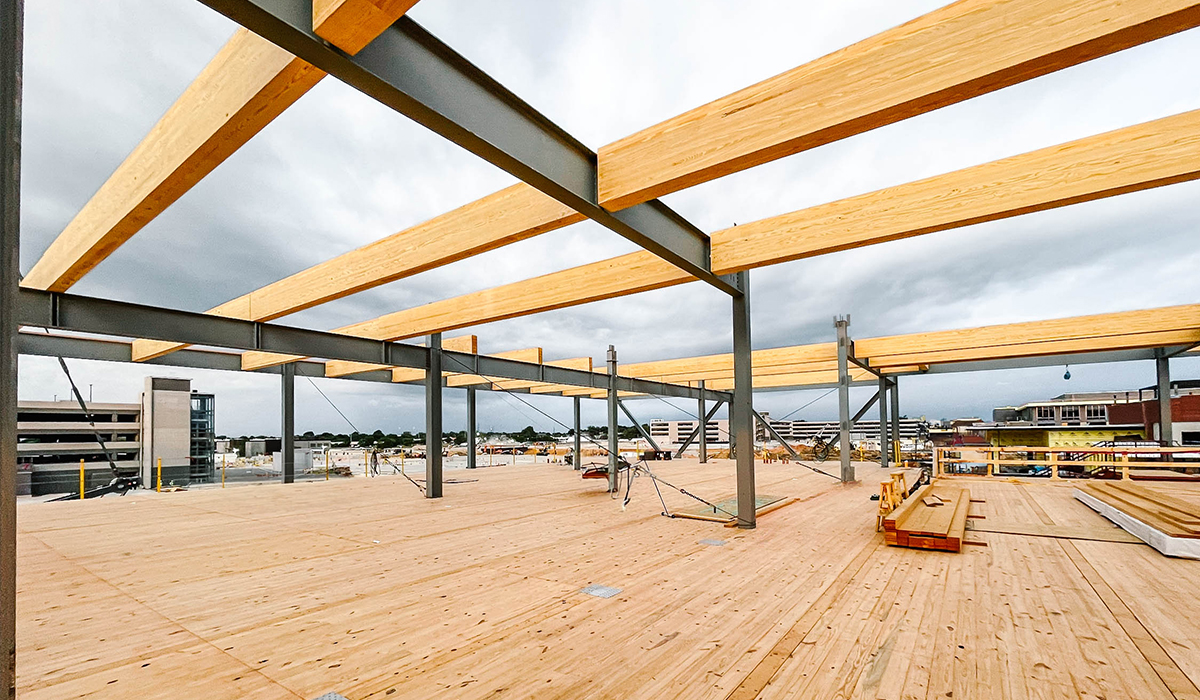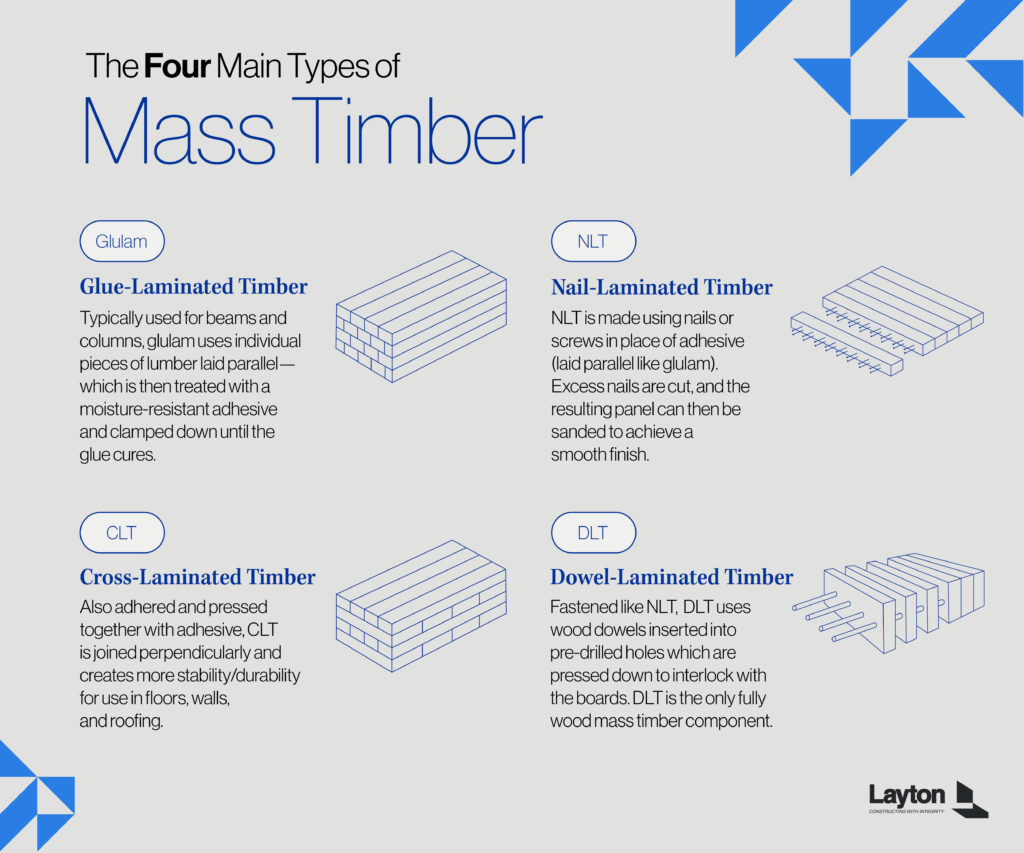The use of mass timber in construction has garnered significant attention across the AEC industry in recent years, with claims it offers a unique combination of strength, versatility, and significant benefits to the environment. However, it’s met with some skepticism as a sound structural alternative to concrete and steel.
As interest in this product type continues to increase, we decided to answer a few of the most common questions we get: What is mass timber? What makes it sustainable? Can a commercial building made of wood really be fire resistant?
Here’s what we’ve learned as the construction manager over one of the most prominent ongoing mass timber projects in the U.S.
Starting from the Roots: What Is Mass Timber?
By definition, mass timber is a type of engineered wood used in load-bearing components (panels and beams) on large-scale construction projects. Simply put, it’s joining layers of dimensional lumber (think 2x4s) to create a much stronger, more rigid material. Mass timber itself falls into several categories (depicted below), with each type lending itself to a range of applications—offering versatility, strength, design flexibility, and more.
Outside a building’s foundation, these robust structural elements can be used in place of concrete and steel virtually anywhere. The design and engineering of mass timber structural systems require specialized expertise and careful consideration of load distribution, connections, and lateral stability. It’s also susceptible to moisture damage, which can lead to rot, decay, and structural degradation. Proper moisture management strategies, including effective vapor barriers, weather-resistant coatings, and moisture monitoring, are essential to safeguard the integrity and longevity of mass timber structures.
The New Champion of Sustainability?
The primary advantage propelling interest in mass timber lies in its diminished carbon impact. Trees actively sequester carbon, and as a result, a mass timber structure substantially curbs emissions when contrasted with conventional concrete and steel. The latter materials emit carbon during both manufacturing and installation.
Of course, it’s worth noting that steel and concrete aren’t the sole contributors to this issue, and their integral role in construction makes it impractical to entirely replace them. Even in hybrid mass timber buildings—where concrete, steel, and timber are combined—there’s significantly less concrete involved.
Here are some real numbers to consider: between concrete production, transportation, pouring, and curing, a typical five-story concrete structure may have an emission level of 1,000 tons of CO2. The reduced emission levels of a five-story timber building are equivalent to removing approximately 600 cars from the road each year.
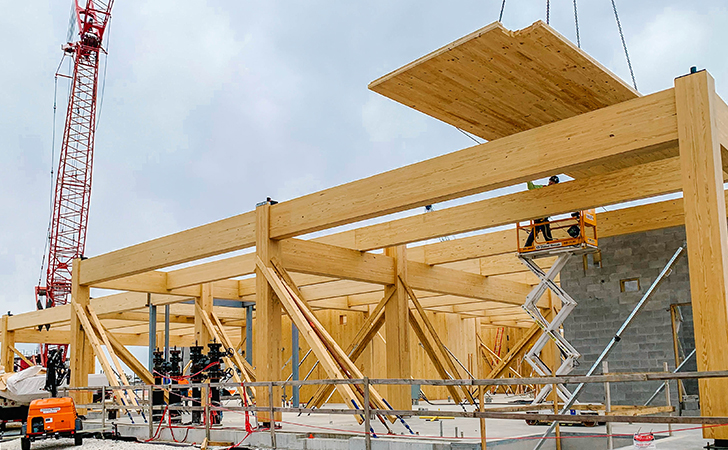
CLT deck being set on a confidential mass timber project in Arkansas. Even in hybrid mass timber buildings—where concrete, steel, and timber are combined—there’s significantly less concrete involved. For example, a traditional steel-structure building might require 5½-6 inches of concrete for the decking, while a mass timber building will typically have only two inches.
A Surprising Misconception: Concerns About Deforestation
It’s difficult to see how cutting down trees for mass timber production wouldn’t contribute to deforestation. But if responsible forest practices are implemented, mass timber remains a viable and eco-friendly approach to diminishing carbon emissions.
“On the surface, logging might not seem like a sustainable practice, but if done correctly, it actually helps maintain our forests by clearing out dead growth, making room for healthy growth, and reducing the risk of massive forest fires.” Steve Knowles, Construction Manager for Layton. Trees used for mass timber are cut in an alternating manner when sourced, which not only enables those remaining to continue growing, but provides greater natural resources for them to do so.
Lastly, and most surprisingly, the rate of tree growth is much more rapid than commonly perceived. Consider the state of Arkansas, where a staggering 19 million acres of trees thrive. Almost 12 billion trees spanning 56% of the state’s landscape generate a remarkable 71 tons of wood fiber every minute. To put this in perspective, two projects undertaken at the University of Arkansas Fayetteville utilized 175,000ft3 of mass timber components (roughly twice the volume of an Olympic-size swimming pool). This volume alone can be regenerated within the state in just three hours! With that, in the time it takes for a single truckload of timber to journey from the factory to the construction site and back, the forest will have already replenished all the wood fiber required for both projects.
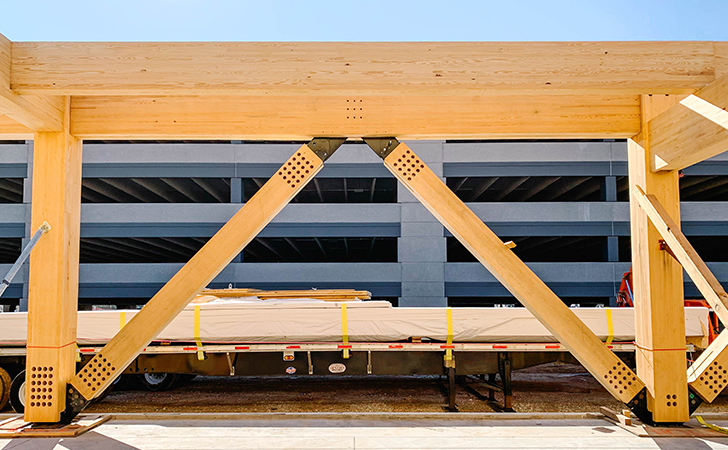
Installed glulam cross bracing.
From Forest to Flame: Fire-Resistant Lumber?
The sustainability of a material encompasses more than just its environmental effects; durability and longevity also contribute significantly. In the construction industry, the preference for utilizing steel and concrete within structural systems stems from their decreased susceptibility to fire hazards and their capacity to withstand fire incidents.
Due to its unique assembly, mass timber possesses inherent fire-resistant qualities that are absent in conventional lumber. Mass timber exhibits an impressive char rating. When subjected to fire, its outer layer chars, forming an insulating barrier that safeguards the inner core while effectively retarding the progression of flames.
That’s not to say the worry ends there. These structures do require specific, additional fire protection measures that owners and builders alike must account for, especially for larger buildings. Fire-rated assemblies, active fire suppression systems, and adherence to fire safety regulations are crucial to mitigate fire risks effectively, and there may be additional costs associated with those.
The Cost of Doing Something New
Ongoing innovation with mass timber continues to increase its sustainability and financial viability. For instance, fabrication advancements have enabled smaller sections of wood to be laminated—increasing the usable material from a tree.
In short, mass timber does prove to be cheaper per square foot—for now at least. But a still-nascent market can be misleading where innovation is concerned. “It can take time for the market to normalize when it comes to labor and working with different materials, even if the cost of working with those materials aren’t inherently higher,” says David Briefel, Sustainability Director & Design Resilience Leader at Gensler, a global architecture, design, and planning firm and Layton’s partner on a six-building mass timber office campus in Arkansas.
Cost of materials is one thing. Cost associated with quality control is another. As we’ll detail below, there’s a decently steep learning curve tied to the proper use (and care) of mass timber, and unless a team knows what to look for, materials may be vulnerable to catastrophic damage.
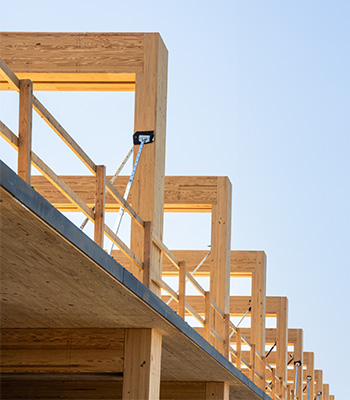
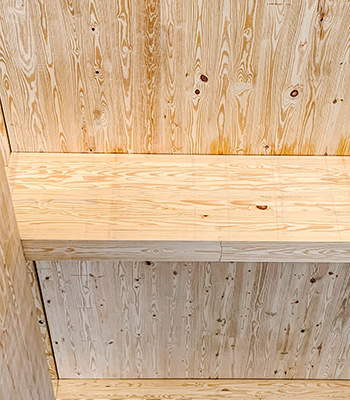
Building with Mass Timber: A Look from the Field
Explaining the ins and outs of working with mass timber is easy, but only first-hand experience tells the whole story. From the field, the process presents several nuances not apparent to the untrained eye, yet crucial to the final product. We sat down with two members of the Layton team currently constructing a six-building mass timber project in Arkansas to gain some insight on what the process involves and what they’re accounting for with this product on site.
While mass timber offers impressive benefits, it takes a lot of work—including climbing a steep learning curve—to reach them.
Working Against the Grain
The tolerances of structural lumber are much tighter than steel. To get the right seal, the pieces must fit together perfectly. “If a piece isn’t plumb, it’s not going to fit and it won’t be useable,” explains Charlie Taylor, General Superintendent with Layton. “You’re also working with a material more finicky than steel. Different species, like pine, have a tendency to swell, so you have to consider how the climate will impact it as the weather shifts from hot to cold, and vice versa,” adds Hugh Sanford, Layton Senior Project Manager.
Since mass timber is exposed as an aesthetic component, one of Taylor’s main concerns is always climate control. “We’re constantly assessing how soon we can get air conditioning on the wood to maintain a consistent temperature and keep it from swelling,” he said, adding, “exposure to direct sunlight is also a factor. Timber can bleach if left in the sun for too long.” Working fast to get the product erected and protected from the elements is imperative and goes beyond the goal of merely hitting the schedule.
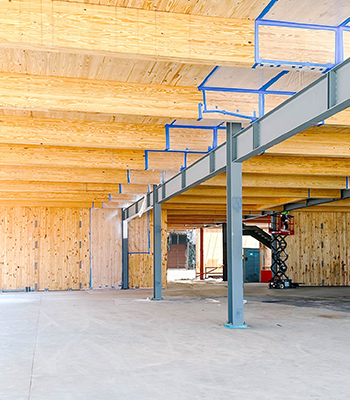
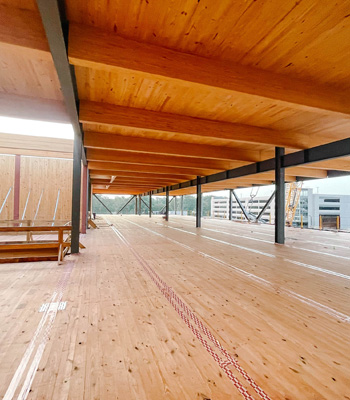
Left: CLT shear wall. Right: CLT deck (and the cleanest operating jobsite we’ve ever seen!).
Once erected, you’re essentially working with a finished product—one that will be visible when all is said and done. That demands a strict quality control process and careful protection during installation and all other stages of construction. “When we fly in steel, there’s little worry about the aesthetics. That’s not the case with mass timber,” explains Taylor. This is where extensive protective measures come into play. “It’s like having a team of nurses out there checking a patient’s temperature every 10 minutes,” he continues. “We have to check the moisture content of every element. We use squeegees and vacuums to ensure water doesn’t pool up.”
Once MEP trades come in, those careful measures remain, and even increase. Taylor explains, “Everything has to be absolutely protected. It’s to the point where we have cameras watching.” Sanford adds to his point, “We’re worried about everything from scissor lifts hitting the columns to sprinkler shavings and oil dropping on the floor.” When it comes to protecting the mass timber, our teams go to whatever lengths are necessary.
With the right people on the job, however, concerns dwindle quickly. “It’s been a fast learning curve for everyone—seeing what to do and what not to do”, says Taylor. He adds, “You have to be smart, and you have to be fast and work in a controlled manner. We’re seeing that with the teams we have on site.”
The takeaway? Mass timber requires a shift in quality control efforts from project managers down to trade partners. It demands expertise and an appreciation for the overall care this product type requires. Knowing that at bid time and planning ahead is crucial. “From a project management perspective, you have to acknowledge these factors and bid it that way. Quality control is going to be a key part of the process and we need trade partners who’ve accounted for that,” says Sanford.
Mass Timber and its Potential Moving Forward
The construction industry is ever evolving. From hard hats to HVAC and risk management to robots, innovation is happening on every jobsite. Few changes, however, catch the eye of the outside observer or end user. Innovations in a building’s structural system, for example, are typically unlikely to be noticed. As a central feature of a building’s aesthetics—and perhaps of the owner’s commitment to environmental stewardship—mass timber is notable and noticeable. Time (and data) will tell whether it meets performance expectations, and if it’s truly worth the hype.
In any case, client interest in mass timber continues to increase, and Layton is well equipped to speak first-hand of the benefits and critical construction considerations. By understanding the various types of mass timber and addressing associated risks—while harnessing the value it surely offers—we can embrace the innovative material as it paves the way for a greener and more resilient future.
About Layton Construction
Layton Construction is a privately held national general contractor, delivering predictable outcomes in commercial construction since 1953. Headquartered in Salt Lake City, Utah, Layton operates from 16 strategic offices across the United States, employing more than 1,400 construction professionals who serve diverse markets including healthcare, education, commercial office, industrial, hospitality, and multi-unit residential. Founded on the core values of honesty, unity, safety, and quality, Layton has built a reputation for excellence in complex project delivery while maintaining strong partnerships with clients, architects, and trade partners nationwide.

Considering the complexities of cold storage facilities, their construction demands a specialized approach and expertise. And with such a rapidly growing market, key players like Layton are primed and poised to step up.
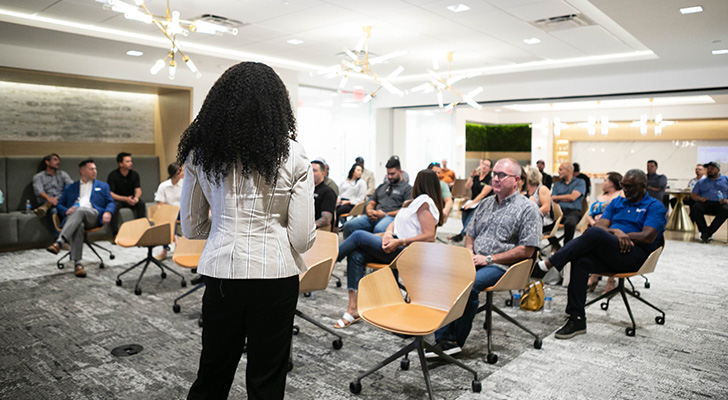
Layton depends heavily on the expertise and capabilities of our trade partners. Lead by Cherelle Cortez, our Trade Partner Engagement and Development team is focused on increasing the diversity and strength of our trade partners.

